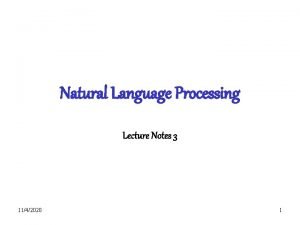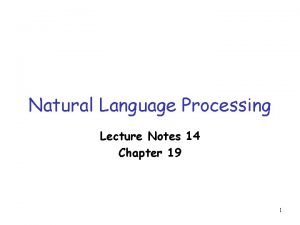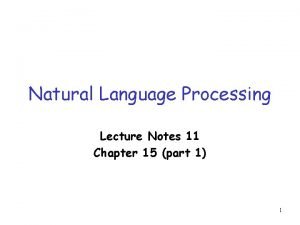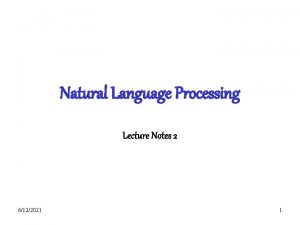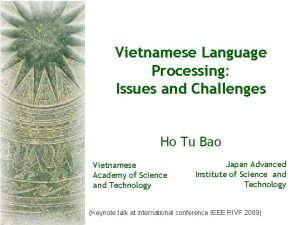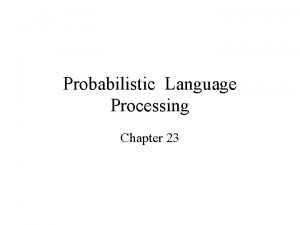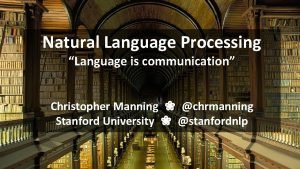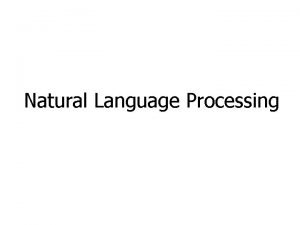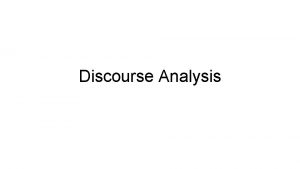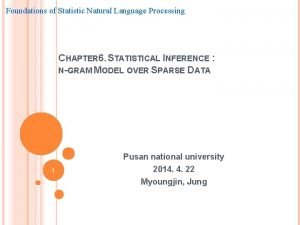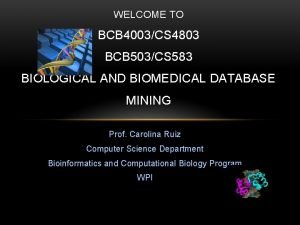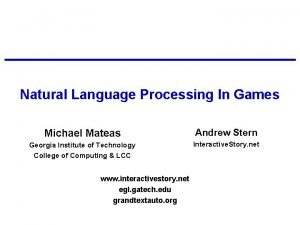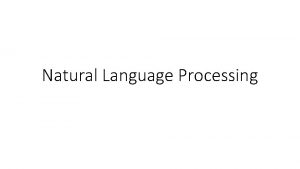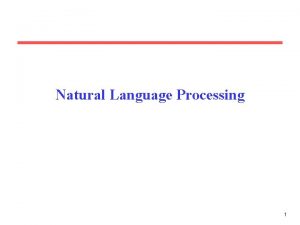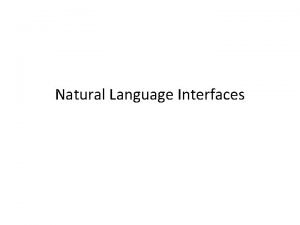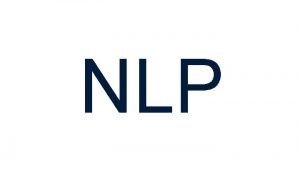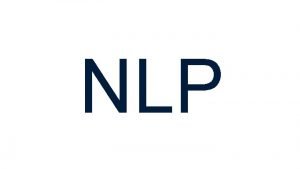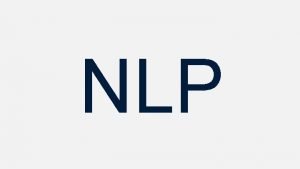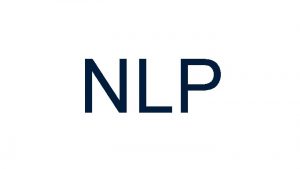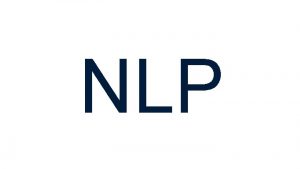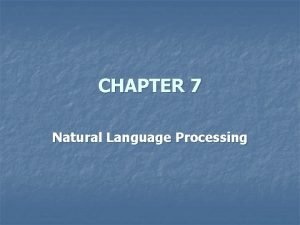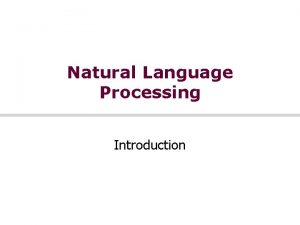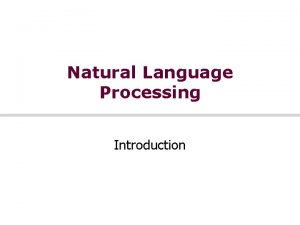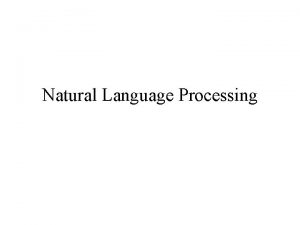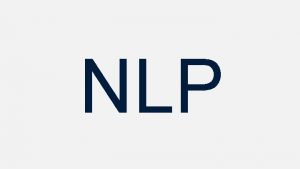Lecture 20 of 41 Natural Language Processing NLP
















- Slides: 16

Lecture 20 of 41 Natural Language Processing (NLP) Survey Automatic Speech Recognition (ASR) aka Speech-to-Text & Machine Translation (MT) William H. Hsu Department of Computer Science, KSU Canvas course redirector: http: //bit. ly/kstate-ai-class Course web site: http: //kdd. cs. ksu. edu/Courses/CIS 530/ Instructor home page: http: //www. cs. ksu. edu/~bhsu Reading for Today: § 22. 1 – 22. 3, p. 860 – 873, R&N 3 e § 23. 4 – 23. 5, p. 907 – 918, R&N 3 e Reading for Next Class: § 12. 3, p. 446 – 450, R&N 3 e CIS 530 / 730 Artificial Intelligence Lecture 20 of 41 Part A (1 of 2) Department of Computer Science Kansas State University

Lecture Outline l Last Class: Semantic Nets & Ontologies, § 12. 1 – 12. 2 (p. 437 – 445), R&N 3 e Semantic Networks Role in knowledge representation (KR) & knowledge engineering (KE) l Today: NLP Intro, § 22. 1 – 22. 3 (p. 860 – 873), 23. 4 – 23. 5 (p. 907 – 918); R&N 3 e Natural Language Processing (NLP) General tasks: translation, story understanding, speech, conversation Specialized tasks: information extraction, question answering (QA) Methods: parsing, learning for pattern recognition Models: statistical (Bayesian) – Hidden Markov Models (HMMs), etc. l Automatic Speech Recognition (ASR) aka Speech-to-Text l Text-To-Speech and Conversation l Statistical Machine Translation (SMT) l Document Understanding: Topic Modeling, Classification l Language Models l Next: More on Production Systems, Implementing Reasoners for Frame Problem l Later This Week: Analogy, Case-Based Reasoning; Probability Review CIS 530 / 730 Artificial Intelligence Lecture 20 of 41 Part A (1 of 2) Department of Computer Science Kansas State University

Where we Are Today CIS 530 / 730 Artificial Intelligence Lecture 20 of 41 Part A (1 of 2) Department of Computer Science Kansas State University

Learning Framework for Natural Language: (Hidden) Markov Models l Definition of Hidden Markov Models (HMMs) Stochastic state transition diagram (HMMs: states, aka nodes, are hidden) Compare: probabilistic finite state automaton (Mealy/Moore model) Annotated transitions (aka arcs, edges, links) • Output alphabet (the observable part) • Probability distribution over outputs A 0. 4 B 0. 6 E 0. 1 F 0. 9 l Forward Problem: One Step in ML Estimation Given: model h, observations (data) D 0. 4 0. 5 0. 8 0. 6 Estimate: P(D | h) l Backward Problem: Prediction Step Given: model h, observations D Maximize: P(h(X) = x | h, D) for a new X l Forward-Backward (Learning) Problem Given: model space H, data D 1 A 0. 5 G 0. 3 H 0. 2 0. 5 2 3 0. 2 C 0. 8 D 0. 2 E 0. 3 F 0. 7 A 0. 1 G 0. 9 Find: h H such that P(h | D) is maximized (i. e. , MAP hypothesis) l HMMs Also A Case of LSQ (f Values in [Roth, 1999]) CIS 530 / 730 Artificial Intelligence Lecture 20 of 41 Part A (1 of 2) Department of Computer Science Kansas State University

Topic Modeling “Probabilistic Topic Models”, D. Blei (2012) – http: //bit. ly/topic-models-blei-cacm https: //youtu. be/Fkckgw. MHP 2 s CIS 530 / 730 Artificial Intelligence Lecture 20 of 41 Part A (1 of 2) Department of Computer Science Kansas State University

Document Categorization Apps: Arts, Sciences, Medicine, Law Digital Arts http: //bit. ly/digitalarts-tutorials Computational Medicine, Heath, & Biology (Bioinformatics & Medical/Health Informatics) http: //portal. ncibi. org/gateway/ Citation Network of U. S. Supreme Court Decisions (Bommarito et al. , 2010) Computational Law http: //bit. ly/complaw-citation-net CIS 530 / 730 Artificial Intelligence Lecture 20 of 41 Part A (1 of 2) Department of Computer Science Kansas State University

Sentiment Analysis Yang & Hsu (2015) CIS 530 / 730 Artificial Intelligence Lecture 20 of 41 Part A (1 of 2) Department of Computer Science Kansas State University

Author-Topic Models & Expert Finders Yang & Hsu (2016) CIS 530 / 730 Artificial Intelligence Lecture 20 of 41 Part A (1 of 2) Department of Computer Science Kansas State University

Information Extraction Tasks: RTE, Summarization, QA l Recognizing Textual Entailment (RTE) Determine when meaning of text logically follows from that of another Approaches: text categorization, semantic mapping, inference Related to question answering: “true/false” questions l Update Summarization Produce brief synopsis of points in text where user has read others Approaches: formal summarization, natural language (NL) synthesis Related to question answering: collect relevant documents, digest l Question Answering (QA) Respond to query posed in natural language Approaches: search, focused crawling, semantic mapping CIS 530 / 730 Artificial Intelligence Lecture 20 of 41 Part A (1 of 2) Department of Computer Science Kansas State University

Recognizing Textual Entailment: Examples SOURCE: A bus collision with a truck in Uganda has resulted in at least 30 fatalities and has left a further 21 injured. TARGET: 30 die in a bus collision in Uganda. S⊨T SOURCE: Mrs. Trump’s approval ratings have remained above 50%, even as her husband's have recently dropped below 40%. TARGET: Over 50% approve of Mr. Trump. S⊭T SOURCE: Take consumer products giant Procter and Gamble. Even with a $1. 8 billion Research and Development budget, it still manages 500 active partnerships each year, many of them with small companies. TARGET: 500 small companies are partners of Procter and Gamble. S⊭T CIS 530 / 730 Artificial Intelligence Lecture 20 of 41 Part A (1 of 2) Department of Computer Science Kansas State University

Update Summarization: Examples SOURCE: A 2001 Ford Excursion limousine collision with a 2015 Toyota Highlander in upstate New York has resulted in at least 20 fatalities in the deadliest transportation accident in the USA since 2009. TARGET: 20 people were killed in a collision in NY state. SOURCE: Mrs. Trump’s approval ratings have remained above 50%, even as her husband's have recently dropped below 40%. TARGET: President Trump’s approval ratings have decreased to less than 40%. SOURCE: Take consumer products giant Procter and Gamble. Even with a $1. 8 billion R&D budget, it still manages 500 active partnerships each year, many of them with small companies. TARGET: Procter and Gamble has 500 partnerships per year. CIS 530 / 730 Artificial Intelligence Lecture 20 of 41 Part A (1 of 2) Department of Computer Science Kansas State University

Question Answering: Examples l Spatial Queries ===> What cities are within 250 miles of the capital of Italy? I know that Italy's capital is Rome, Italy (source: START KB). Using this information, I determined what cities are within 250 miles of Rome, Italy: In Italy, the following cities are within 250 miles of Rome: Naples, Italy is 118 miles (189. 90298 kilometers) from Rome. [Florence, Pisa, Bologna, Venice, Trieste, Verona] Genoa, Italy is 249 miles (400. 72745 kilometers) from Rome. Source: START KB [http: //start. csail. mit. edu] http: //bit. ly/UBq 4 q © 2005 J. Sankaranarayanan University of Maryland l Skyline Queries Used in constrained decision support Given: points p 1, p 2, …, p. N, each in d dimensions Return: maximal (non-dominated) points – i. e. , Pareto front QA: interpretation of NL queries (including skyline) CIS 530 / 730 Artificial Intelligence Lecture 20 of 41 Part A (1 of 2) Department of Computer Science Kansas State University

Approach: Parsing for Semantic Role Labeling (SRL) l Algorithms SRL Text generation Semantic Role Labeling Demo http: //l 2 r. cs. uiuc. edu/~cogcomp/srl-demo. php © 2009 University of Illinois l Knowledge Representation: Parse Trees, Abstract Data Types l Other Tasks Filling in abstract data types (ADTs) aka frames, slot-filler structures Natural language generation, content evaluation CIS 530 / 730 Artificial Intelligence Lecture 20 of 41 Part A (1 of 2) Department of Computer Science Kansas State University

NLP Issues: Word Sense Disambiguation (WSD) l Problem Definition Given: m sentences, each containing a usage of a particular ambiguous word Example: “The can will rust. ” (auxiliary verb versus noun) Label: vj s correct word sense (e. g. , s {auxiliary verb, noun}) Representation: m examples (labeled attribute vectors <(w 1, w 2, …, wn), s>) Return: classifier f: X V that disambiguates new x (w 1, w 2, …, wn) l Solution Approach: Use Bayesian Learning (e. g. , Naïve Bayes) Caveat: can’t observe s in the text! A solution: treat s in P(wi | s) as missing value, impute s (assign by inference) [Pedersen and Bruce, 1998]: fill in using Gibbs sampling, EM algorithm (later) [Roth, 1998]: Naïve Bayes, sparse networks of Winnows (SNOW), TBL l Recent Research T. Pedersen’s research home page: http: //www. d. umn. edu/~tpederse/ D. Roth’s Cognitive Computation Group: http: //l 2 r. cs. uiuc. edu/~cogcomp/ CIS 530 / 730 Artificial Intelligence Lecture 20 of 41 Part A (1 of 2) Department of Computer Science Kansas State University

NLP Issues: Part-of-Speech (POS) Tagging Speech Acts l Problem Definition Given: m sentences containing untagged words Example: “The can will rust. ” Discourse Labeling Parsing / POS Tagging Label (one per word, out of ~30 -150): vj s (art, n, aux, vi) Representation: labeled examples <(w 1, w 2, …, wn), s> Lexical Analysis Return: classifier f: X V that tags x (w 1, w 2, …, wn) Natural Language Applications: WSD, dialogue acts (e. g. , “That sounds OK to me. ” ACCEPT) l Solution Approaches: Use Transformation-Based Learning (TBL) [Brill, 1995]: TBL - mistake-driven algorithm that produces sequences of rules • Each rule of form (ti, v): a test condition (constructed attribute) and tag • ti: “w within k words of wi” (context words); collocations (windows) For more info: see [Roth, 1998], [Samuel, Carberry, Vijay-Shankar, 1998] l Recent Research E. Brill’s page: http: //www. cs. jhu. edu/~brill/ K. Samuel’s page: http: //www. eecis. udel. edu/~samuel/work/research. html CIS 530 / 730 Artificial Intelligence Lecture 20 of 41 Part A (1 of 2) Department of Computer Science Kansas State University

NLP Applications: Info Retrieval (IR) and Digital Libraries l Information Retrieval (IR) One role of learning: produce classifiers for documents (see [Sahami, 1999]) Query-based search engines (e. g. , for WWW: Alta. Vista, Lycos, Yahoo) Applications: bibliographic searches (citations, patent intelligence, etc. ) l Bayesian Classification: Integrating Supervised/Unsupervised Learning Unsupervised learning: organize collections of documents at a “topical” level e. g. , Auto. Class [Cheeseman et al, 1988]; self-organizing maps [Kohonen, 1995] More on this topic (document clustering) soon l Framework Extends Beyond Natural Language Collections of images, audio, video, other media Five Ss : Source, Stream, Structure, Scenario, Society Book on IR [van. Rijsbergen, 1979]: http: //www. dcs. gla. ac. uk/Keith/Preface. html l Recent Research M. Sahami’s page (Bayesian IR): http: //robotics. stanford. edu/users/sahami Digital libraries (DL) resources: http: //fox. cs. vt. edu CIS 530 / 730 Artificial Intelligence Lecture 20 of 41 Part A (1 of 2) Department of Computer Science Kansas State University
 Natural language processing
Natural language processing Natural language processing lecture notes
Natural language processing lecture notes Natural language processing lecture notes
Natural language processing lecture notes Natural language processing lecture notes
Natural language processing lecture notes Natural language processing lecture notes
Natural language processing lecture notes Natural language processing lecture notes
Natural language processing lecture notes Nlp lecture notes
Nlp lecture notes Natural language processing vietnamese
Natural language processing vietnamese Probabilistic model natural language processing
Probabilistic model natural language processing Markov chain natural language processing
Markov chain natural language processing Language
Language Grammar adalah
Grammar adalah Natural language processing
Natural language processing Foundations of statistical natural language processing
Foundations of statistical natural language processing Natural language processing fields
Natural language processing fields Statistical nlp
Statistical nlp Natural language processing games
Natural language processing games



